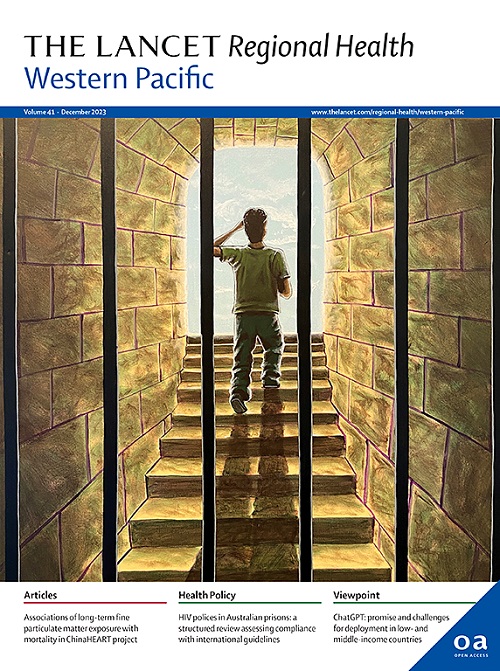多民族人群卒中发病率、死亡和残疾结局的趋势:奥克兰地区社区卒中研究(1981-2022)
IF 7.6
1区 医学
Q1 HEALTH CARE SCIENCES & SERVICES
引用次数: 0
摘要
背景:对于评估公共卫生和临床策略的有效性,以及分配医疗资源,卒中发病率和预后随时间变化趋势的可靠数据是必要的。我们评估了40多年来确定的种族混合人群中卒中发病率、死亡率、早期病死率和致残率的水平和趋势。方法分析1981-1982年、1991-1992年、2002-2003年、2011-2012年和2021-2022年12个月期间新西兰大奥克兰地区成人居民(年龄≥15岁)(135万人)的5项基于人群的脑卒中发病率研究数据。致命性和非致命性、住院和非住院卒中事件(首次和复发)通过多个重叠来源确定,使用临床世界卫生组织(WHO)诊断标准和神经影像学来确定卒中的三种主要病理类型:缺血性卒中(IS)、原发性脑出血(PICH)、蛛网膜下腔出血(SAH)和未确定类型的卒中(SUT)。粗糙的和年龄标准化的年发病率、死亡率、28天病死率和残疾水平以及40年的趋势按年龄、性别和种族计算,假设泊松分布。为了比较我们的发现,我们对过去二十年来高收入国家基于人群的卒中流行病学估计进行了方法上可比较的汇总分析。总体而言,在40年(4,682,012人年)期间,有7462例首次中风(9917例)。从1981-1982年到2021-2022年,年龄标准化脑卒中发病率从156/10万下降(95%可信区间[CI] 143;170)到124/100,000 (119;130),死亡率为98/100 000 (88;110)至28/100,000 (26;31)几乎所有年龄、性别和种族的人都是如此。此外,从2002-2003年到2021-2022年,15-54岁人群的卒中发病率每年增加1.28% (95% CI 0.38-2.17),卒中患者的平均年龄从2002-2003年的73.0岁(SD±13.8)降至2011-2012年的71.6岁(SD±14.9),2021-2022年的70.7岁(SD±15.2)岁(p为趋势值<;0.0001)。在2021-2022年期间,Māori和太平洋人中风的风险几乎是新西兰欧洲人的1.5倍和2.0倍。在研究期间,中风风险和中风发病年龄的种族差异保持稳定。从1981-1982年到2021-2022年,28天中风病死率从33.1%下降到12.1% (p <;0.0001)。有降低28天病死率的趋势(从31.6% [95% CI 27.6;35.7%] 1981-1982年为11.4% [10.0];12.7] 2021-2022年),出院时/卒中后28天功能预后良好的卒中幸存者比例增加(从45.7% (95% CI 41.3;50.0)上升至60.2% (58.1;62.3)(2021-2022)。在过去的40年里,新西兰奥克兰的中风发病率、1年死亡率、28天病死率和致残率都有所下降。然而,在过去十年(2011-2022年)中,年龄标准化脑卒中发病率的下降停滞不前。从1981年到2022年,中风患者、因中风死亡或残疾的绝对人数显著增加。中风风险和负担的种族差异仍然存在。有效的中风预防战略必须保持高度优先。新西兰卫生研究理事会。本文章由计算机程序翻译,如有差异,请以英文原文为准。
Trends in stroke incidence, death, and disability outcomes in a multi-ethnic population: Auckland regional community stroke studies (1981–2022)
Background
Reliable data on trends of stroke incidence and outcomes over time are necessary for assessing the effectiveness of public health and clinical strategies, and for allocating healthcare resources. We assessed the levels and trends in incidence, mortality, early case fatality and disability for stroke in a defined, ethnically mixed population over 40 years.
Methods
To analyse data from five population-based stroke incidence studies in adult residents (age ≥15 years) of the Greater Auckland Region of New Zealand (NZ) (1.35 million) over 12-month calendar periods for 1981–1982, 1991–1992, 2002–2003, 2011–2012, and 2021–2022. Fatal and non-fatal, hospitalised and non-hospitalised stroke events (first-ever and recurrent) were identified through multiple overlapping sources using clinical World Health Organization (WHO) diagnostic criteria and neuroimaging to define three major pathological types of stroke: ischaemic stroke (IS), primary intracerebral haemorrhage (PICH), subarachnoid haemorrhage (SAH), and stroke of undetermined type (SUT). Crude and age-standardised annual incidence, mortality, 28-day case fatality and disability level, and 40-year trends were calculated by age, sex, and ethnicity assuming a Poisson distribution. For comparison of our findings, we carried out a pooled analysis of methodologically comparable population-based stroke epidemiology estimates in high-income countries over the last two decades.
Findings
Overall, there were 7462 first-ever strokes (9917 events) over the 40-year period (4,682,012 person-years). From 1981–1982 to 2021–2022, age-standardised stroke incidence rates decreased from 156/100,000 (95% confidence interval [CI] 143; 170) to 124/100,000 (119; 130) and mortality rates from 98/100,000 (88; 110) to 28/100,000 (26; 31) in nearly all age, sex, and ethnic groups. Moreover, from 2002–2003 to 2021–2022, there was an increase in stroke incidence of 1.28% per year (95% CI 0.38–2.17) in people aged 15–54 years, with the mean age of people with stroke decreasing from 73.0 (SD ± 13.8) in 2002–2003 to 71.6 (SD ± 14.9) in 2011–2012 and 70.7 (SD ± 15.2) years in 2021–2022 (p for trend <0.0001). The risk of stroke in Māori and Pacific people in 2021–2022 was almost 1.5 and 2.0 times greater than that in NZ Europeans. Ethnic disparities in the risk of stroke and age of stroke onset remained stable over the study period. From 1981–1982 to 2021–2022, 28-day stroke case fatality declined from 33.1% to 12.1% (p < 0.0001). There was a trend towards reducing 28-day case-fatality (from 31.6% [95% CI 27.6; 35.7] in 1981–1982 to 11.4% [10.0; 12.7] in 2021–2022) and an increasing proportion of stroke survivors with good functional outcome at discharge/28-days post-stroke (increased from 45.7% (95% CI 41.3; 50.0) in 1981–1982 to 60.2% (58.1; 62.3) in 2021–2022).
Interpretation
Stroke incidence, 1-year mortality and 28-day case-fatality and disability have decreased in Auckland, NZ over the last 4 decades. However, over the last decade (2011–2022) there was a stagnation in the decline in the age-standardised stroke incidence rates. The absolute numbers of people with strokes, and those who have died or remained disabled from stroke, have significantly increased from 1981 to 2022. Ethnic disparities in the risk and burden of stroke persist. Effective prevention strategies for stroke must remain a high priority.
Funding
Health Research Council of New Zealand.
求助全文
通过发布文献求助,成功后即可免费获取论文全文。
去求助
来源期刊

The Lancet Regional Health: Western Pacific
Medicine-Pediatrics, Perinatology and Child Health
CiteScore
8.80
自引率
2.80%
发文量
305
审稿时长
11 weeks
期刊介绍:
The Lancet Regional Health – Western Pacific, a gold open access journal, is an integral part of The Lancet's global initiative advocating for healthcare quality and access worldwide. It aims to advance clinical practice and health policy in the Western Pacific region, contributing to enhanced health outcomes. The journal publishes high-quality original research shedding light on clinical practice and health policy in the region. It also includes reviews, commentaries, and opinion pieces covering diverse regional health topics, such as infectious diseases, non-communicable diseases, child and adolescent health, maternal and reproductive health, aging health, mental health, the health workforce and systems, and health policy.
 求助内容:
求助内容: 应助结果提醒方式:
应助结果提醒方式:


